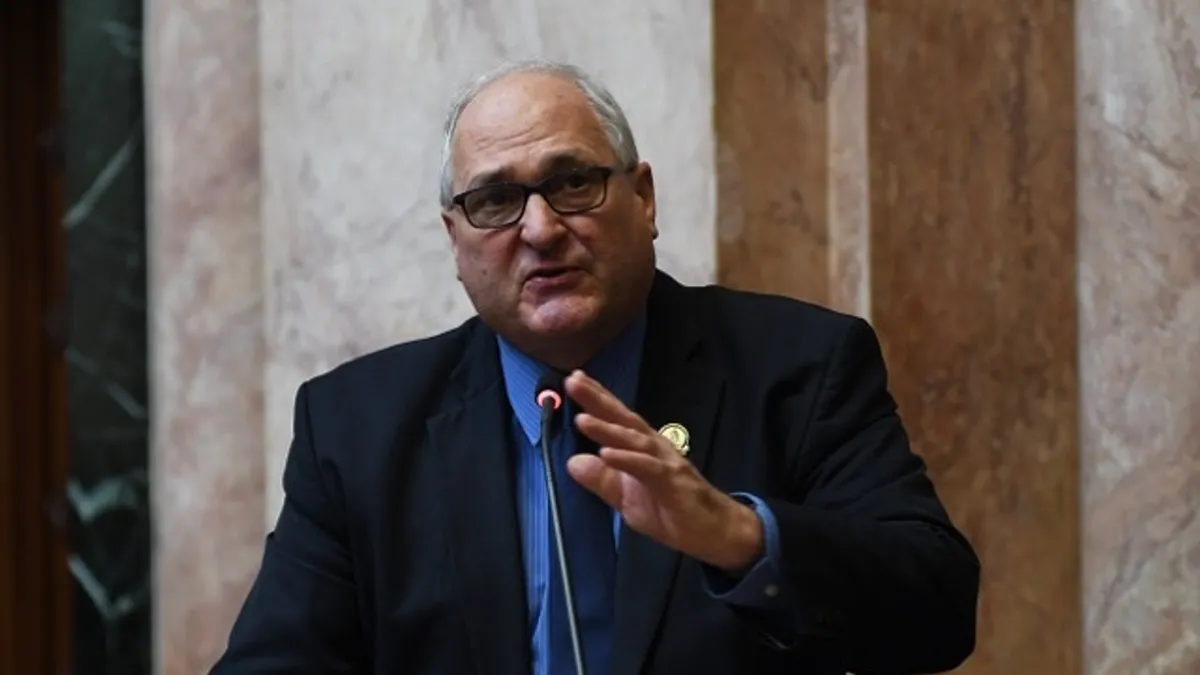Last year, current and former women faculty members at Vassar College filed a lawsuit alleging the private college paid them less than men — a disparity that has remained consistently high over nearly two decades.
The case, which is ongoing, is just one example of women and people of color who say their colleges are paying them unfair wages.
The gender and racial wage gap in higher education stems from “deeply rooted historical inequalities and systemic barriers” that still influences how colleges hire, promote and compensate faculty and staff, Gloria Blackwell, CEO at the American Association of University Women, said in an email.
“The wage gap is not just about numbers on a paycheck — it’s about a legacy of exclusion that shapes our academic institutions even today,” she said.
Still, experts say colleges and universities can take several steps to address pay gaps on their campuses. That includes working with consultants to determine the extent of their institution’s gap, auditing pay and making it more transparent, lessening the role implicit biases play on promotions and pay, and providing better workplace experiences for women and racial and ethnic minorities.
Colleges risk losing top talent if they don’t address the wage gap.
The persistent disparity has made academia an uphill battle for women and people of color — slowing their career progression or keeping them away from the profession altogether, Blackwell said.
“We’re losing bright minds before they even get through the door,” Blackwell said.
How wide is the gap?
It’s hard to nail down the extent of the pay gap.
Today, women in higher ed earn an average of just 82 cents for every $1 that White men make, according to the College and University Professional Association for Human Resources. That gap widens to 76 cents for Black women and 72 cents for Hispanic and Latina women, CUPA-HR found.
CUPA-HR researchers have noticed progress in pay equity for higher ed professionals since the 2016-17 academic year, including among faculty and administrators. That year, Black and White women who worked as tenure-track professors earned 96 cents and 97 cents respectively for every $1 earned by White men. Hispanic and Asian women earned slightly more than White men that year. By the 2022-23 academic year, White women earned 99 cents to every dollar earned by White men, while the gap closed for Black women.
And that improvement is still, “for the most part,” on an upwards trajectory, said Melissa Fuesting, associate director of research at CUPA-HR.
Other groups have landed on different estimates of the gender pay divide.
The Segal Group, a human resources consulting firm, has found that women employed by the range of colleges it works with earn about the mid-90 cent range for every $1 made by men holding the same jobs, said Moshe Mayefsky, a compensation expert and vice president at Segal.
When conducting pay equity studies for universities, Segal compares salary gaps between men and women employees with the same or substantially similar job. The group also factors in variables that differentiate pay, such as experience, said Mayefsky.
The gap could be due to the disproportionate number of men in STEM jobs and full professor positions, which pay more than non-STEM jobs and assistant professorships, Mayefsky said.
The firm has seen promising signs that the gap is narrowing. The disparity Segal researchers noticed has closed a bit since 2010 when women were paid, on average, in the low-90 cents on the dollar range, he said.
Institutions are “doing a pretty decent job, or at least have started pretty well, pretty strong,” at closing the pay gap, said Mayefsky.
What’s behind the pay gap?
Several factors contribute to the pay gap. Much of it can be attributed to labor force experience and time on the job, both of which men tend to have more of, said Paula Cole, a teaching professor at the University of Denver with expertise in the economics of gender, race and inequality.
Culturally, women are still expected to take on more care work in their homes, Cole said. But many universities provide advancement opportunities that do not fit within the working parent’s schedule. Cole gave the example of evening functions when parents — more often mothers — need to tend to their kids.
We’re losing bright minds before they even get through the door.

Gloria Blackwell
CEO at the American Association of University Women
Discrimination also contributes to the pay gap — however, the extent that it does is harder to quantify, she said.
In higher ed, differences exist between the fields that men and women tend to enter — and how those fields are valued, Cole said.
Lower-valued fields often have “more feminine characteristics,” such as care work, while higher-valued fields are often “more masculine in nature,” Cole explained.
Faculty in economics, for instance, which is considered a more masculine field, earn more than faculty in language and literature fields, even though they may conduct the same type of work, Cole said.
“The way that we value those different disciplines is contributing to the problem of the pay gap across universities,” Cole said.
Compensation studies
To solve their pay gaps, institutions need to pinpoint where disparities are and which individuals need their salaries adjusted to close it.
Pay equity studies should look at the responsibilities of the jobs themselves to understand whether gaps truly exist, said Mayefsky. Are there two jobs with similar responsibilities? They will also factor in a range of other variables including seniority, education, tenure status, experience and the credentials that employees may have, he said.
If an institution is paying men more than women, then a representation equity analysis — which reviews whether there is equal representation across fields that may pay different amounts — would then be used to determine why women are in those lower-paying jobs versus the higher-paying ones, said Mayefsky.
An institution may determine it is paying fairly, but doesn’t have a balanced hiring profile. In that case, it would need to train managers and recruiters on how to more equitably hire across, gender, race and ethnicity, he said.
It’s also not enough for institutions to complete a one-time pay equity study and make adjustments to close it without taking steps to address the reasons that caused the gaps, as those divides can “re-emerge over time,” Fuesting said.
“Doing it successfully would require not just doing an adjustment, but really having a process where you’re doing this on a regular basis,” Fuesting said.
Pay transparency
College leaders can also help achieve pay equity by taking steps to ensure pay negotiations during hiring processes are gender equitable, said Cole. Pay negotiation processes have an aggressive nature and have historically favored men over women, said Cole. That’s because men are expected to act masculine by being more assertive and asking for what they want, she explained, traits that are not expected or encouraged of women.
What’s being negotiated is not a lot of money for the university. But it is a lot of money for that individual.

Paula Cole
Professor at the University of Denver
More institutions are implementing transparency policies that provide job seekers, along with internal faculty and staff, with a pay range for open positions, Mayefsky said.
Clear rules and guidelines around the hiring process can help eliminate gender-based gaps during negotiations, Cole said.
“At the end of the day, what’s being negotiated is not a lot of money for the university," said Cole. “But it is a lot of money for that individual.”
The push for pay transparency has been reflected in state law.
Legislators have passed transparency laws in many states, including California, Connecticut, Colorado, Hawaii, Maryland, Nevada, New York, Rhode Island, Washington, Minnesota and Illinois. Colorado’s equal pay laws that took effect in 2021, for instance, require that all job ads list salary ranges and general descriptions of other benefits.
Providing pathways
Colleges can implement a range of policies to help overcome implicit bias and retain employees who are women or people of color.
For instance, some policies can give such faculty members a fair shot of getting on the tenure track, Fuesting said. An April 2024 CUPA-HR study recommended institutions critically evaluate and refine their tenure-track promotion pathways and implement mentorship and allyship programs to help women and people of color navigate them.
But these types of efforts can fall flat if the university doesn’t create welcoming and supportive environments, said Blackwell.
Higher ed leaders, for example, should incorporate policies that allow mothers to take on extra opportunities or travel for research “so they are not penalized for being moms in the workplace,” Cole said.
Policies such as paid parental leave and flexible schedules can help colleges retain women, Blackwell said. However, if such family-friendly policies are not flexible enough to meet the diverse needs of women, they can “miss the mark,” she said.
“A one-size-fits-all approach rarely works when it comes to issues like parental leave or childcare support,” she said.
Addressing implicit biases
Unconscious expectations around gender norms factor into the pay gap in other ways, Cole said.
For instance, studies have shown that students, due to unconscious biases, are more likely to rate White men as better educators than women and people of color. And these student evaluations often factor into decisions about pay raises, Cole said.
College leaders should review policies that use student evaluations to assess educators, Cole said. This is particularly important for women of color, as they’re most likely to receive negative evaluations — regardless of their merit as educators, she added.
Diversity and inclusion training is also important, as long as it goes “beyond just checking a box,” Blackwell said. Such training should enhance awareness of biases and systemic barriers, she said.
Overcoming challenges
Institutions need to overcome several challenges to implement the policies needed to address their wage gaps.
For instance, it can be difficult for college leaders to gather the collective will and resources needed to correct the pay gap, said Cole.
“How do you garner enough institutional support to tackle something that is persistent across universities and outside the university system as well?” she said. “That makes it really difficult.”
When conducting pay equity analyses, consulting group Segal often gets more buy-in from faculty and staff when researchers explain their methodology to those who may be impacted or affected by recommended pay adjustments, Mayefsky said. At times, liberal arts experts nod their heads as he explains the methodology, while mathematics and statistics professors try to poke holes in their math, he said.
Those exchanges are great, said Mayefsky, because the faculty learn about the rigor and effort that goes into those analyses. At that point, “they kind of stand behind it,” he said.





















